Slim trees like Italian Cypress, Sky Pencil Holly, and Emerald Green Arborvitae offer perfect privacy solutions for tight spaces. These columnar varieties reach impressive heights while maintaining narrow widths of just 3-8 feet. You’ll maximize vertical coverage without sacrificing precious square footage in small gardens. Plant them 3-5 feet apart for effective screening, and consider mixing evergreen and deciduous options for year-round interest. Discover how these space-saving sentinels can transform your narrow garden into a private sanctuary.
Why Slim Trees Are Perfect for Tight Spaces

When space comes at a premium in your garden, slim trees offer an elegant solution without sacrificing greenery or visual impact.
These narrow varieties maximize your vertical dimension while minimizing horizontal footprint, allowing you to enhance small gardens with substantial vegetation.
Slim trees stretch skyward while staying narrow, bringing big garden presence to your smallest spaces.
Slim trees like the Sky Pencil Holly reach impressive heights of 10 feet while spreading just 2 feet wide, perfectly fitting confined areas.
You’ll find options like the Slender Silhouette Sweetgum that soar above 60 inches tall while maintaining their svelte profile.
Beyond aesthetics, these space-efficient trees serve practical purposes too.
You can create privacy screens and windbreaks in narrow spaces where traditional wide-canopied trees wouldn’t fit.
Understanding Height and Growth Patterns of Columnar Trees
Selecting the perfect slim tree for your narrow space requires more than just finding an attractive variety—you’ll need to grasp how these columnar specimens develop over time.
Columnar trees maintain their narrow habit naturally, making them ideal candidates for small gardens and tight spots.
Consider these critical factors when planning:
- Mature height varies greatly—from Sky Pencil Holly’s modest 8-10 feet to towering varieties like Slender Silhouette Sweetgum exceeding 60 inches.
- Growth rate differences affect planning—some like Goldspire Ginkgo grow moderately while Crimson Pointe Flowering Plum develops rapidly.
- Width-to-height ratios remain impressively slim, often 5-6 inches wide despite substantial heights.
- Final dimensions must complement your specific location to avoid future conflicts with structures or views.
Understanding these patterns guarantees your columnar trees will enhance rather than overwhelm your space.
Evergreen Options for Year-Round Privacy
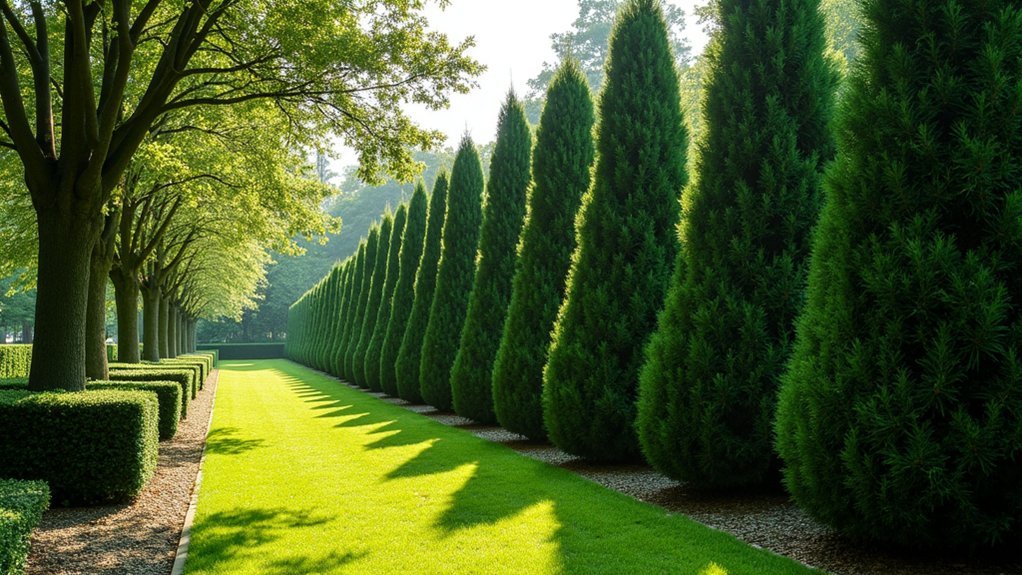
For homeowners seeking privacy solutions that perform consistently throughout all seasons, evergreen columnar trees offer the perfect combination of vertical impact and minimal footprint.
Italian Cypress provides dramatic height, growing up to 3 feet annually and reaching 20-30 feet, while occupying minimal ground space.
If you’re working with a particularly tight area, consider the Sky Pencil Holly. At just 2-3 feet wide but 6-8 feet tall, it’s perfect for small gardens needing vertical structure without horizontal sprawl.
The Emerald Green Arborvitae and Blue Point Juniper both reach 10-15 feet tall while maintaining narrow profiles of 3-4 and 6-8 feet respectively.
For colder climates, Hicks Yew offers impressive privacy at 10-15 feet tall with a slim 3-4 foot width, making it ideal for narrow hedges.
Deciduous Choices With Seasonal Appeal
While evergreens provide consistent privacy, deciduous columnar trees offer dramatic seasonal transformations that can elevate narrow garden spaces.
You’ll enjoy year-round visual interest as these slender trees cycle through their seasonal displays.
The Crimson Pointe Flowering Plum delivers vibrant blooms in spring and maintains purple foliage throughout the growing season.
For spectacular fall colors, consider these options:
- Prunus serrulata Amanogawa, a narrow cherry tree reaching 25 feet with pale pink spring flowers and orange autumn foliage
- Tsukasa Silhouette Japanese Maple, showcasing stunning color changes while growing slowly to 15-20 feet
- Liquidambar styraciflua Slender Silhouette, towering to 60 feet with only 6-8 feet spread
- Goldspire Ginkgo, featuring dark green leaves that transform to brilliant golden yellow in fall
The Fastest Growing Slim Trees for Quick Privacy
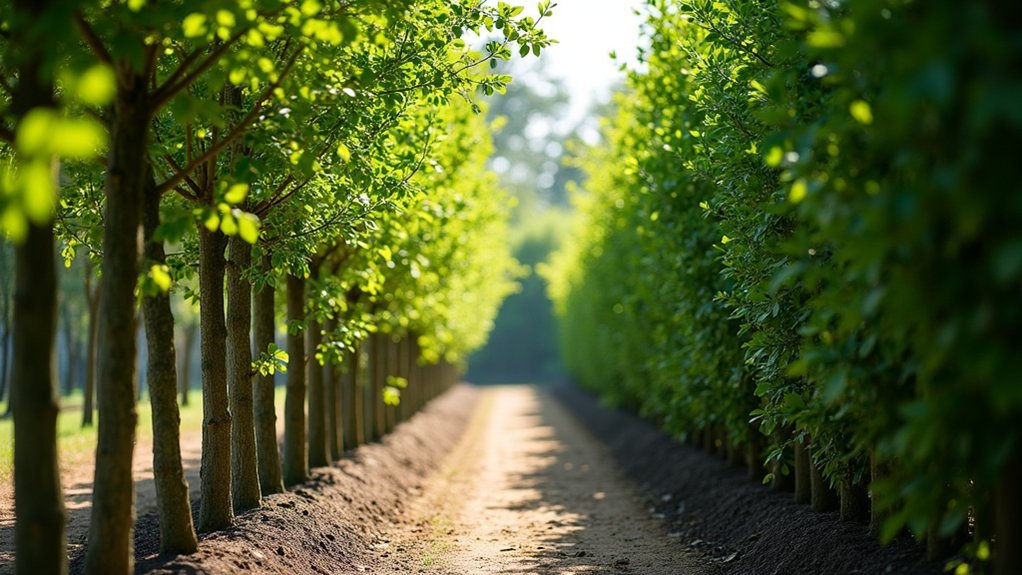
When privacy concerns can’t wait for slow-growing specimens, several columnar varieties offer remarkably quick solutions without consuming precious square footage. The Lombardy Poplar stands out as a champion, adding an impressive 6 feet or more annually, quickly creating a living privacy screen.
Italian Cypress delivers 2-3 feet of growth yearly and can be planted just 3 feet from structures, making it ideal for tight spaces where you need both privacy and windbreak protection.
For smaller gardens, consider the Slender Silhouette Sweetgum, which reaches over 60 inches tall while maintaining a narrow width of only 5-6 inches.
The Sky Pencil Holly provides vertical privacy in minimal space, growing 8-10 feet tall but only 2 feet wide.
Weeping White Spruce offers both privacy and protection, reaching 20-30 feet with a slim 6-10 foot profile.
Ideal Planting Distances for Maximum Screening Effect
To create an effective privacy screen with slim trees, you’ll need to take into account both minimum spacing requirements and mature dimensions.
For most narrow trees, allow 3-4 feet between specimens, adjusting closer (2-3 feet) for columnar varieties like Sky Pencil Holly or farther apart (5-6 feet) for taller species like Slender Silhouette Sweetgum.
You can also apply a simple height-based distance formula: space trees at roughly 1/4 to 1/3 of their expected mature height to balance adequate coverage with healthy growth.
Minimum Spacing Requirements
Finding the perfect spacing for your narrow trees creates the difference between a sparse row of individual specimens and an effective privacy screen.
When planting narrow trees for privacy screening, spacing them 3 to 5 feet apart provides adequate growth while maintaining a dense visual barrier.
Consider these minimum spacing guidelines for ideal growth:
- For slim varieties like Sky Pencil Holly (2-3 feet wide), plant just 2 to 3 feet apart
- Larger selections such as Crimson Spire™ oak need 10 to 15 feet between trees
- Use half the mature width as your general minimum spacing rule
- Fast-growing varieties like Lombardy Poplar need consistent spacing to create a solid privacy screen
Height-Based Distance Formula
Unlike fixed spacing rules, the height-based distance formula provides a flexible approach to achieving perfect screening with slim trees. This practical guideline suggests planting trees at distances equal to their mature height—a 20-foot tree should be spaced 20 feet apart for ideal coverage.
For effective privacy in narrow spaces, adjust accordingly: trees reaching 10-15 feet tall work best planted 10-15 feet apart. Columnar trees like the Lombardy Poplar can be positioned closer (6-10 feet) due to their slim profile, creating quick privacy barriers even in tight areas.
Evergreen trees offer year-round screening—consider Sky Pencil Holly planted 6-8 feet apart for a dense visual barrier.
Always factor in future growth when planning your layout, allowing sufficient space between specimens for healthy development and maximum screening effect as they reach their mature height.
Soil Requirements and Site Preparation for Columnar Trees
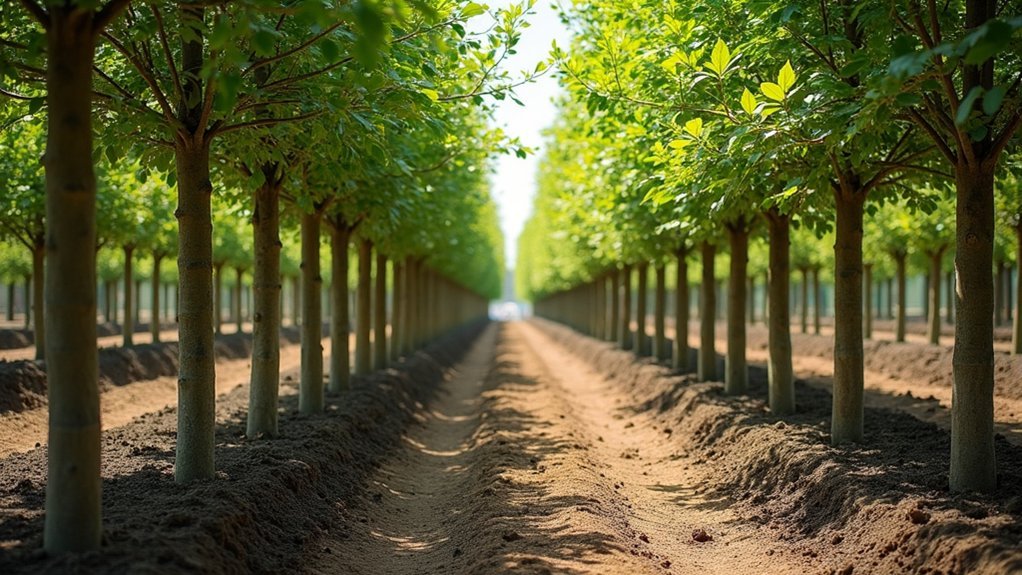
You’ll need to assess your soil’s drainage by digging a test hole and filling it with water to see how quickly it drains, as standing water can quickly kill columnar trees.
Testing your soil’s pH level is essential using an inexpensive home kit or through your local extension office to determine if amendments are needed for your specific tree variety.
Once you’ve gathered this information, you can make targeted improvements to create the ideal growing environment before the first root touches your soil.
Optimal Drainage Assessment
Because columnar trees thrive in specific soil conditions, evaluating your site’s drainage is a critical first step before planting. Conduct a simple soil test by digging a 12-inch hole, filling it with water, and monitoring absorption—slow drainage signals potential problems for root establishment.
You’ll want to verify your soil meets these requirements:
- Well-draining soil with loamy texture and pH between 6.0-7.0
- No standing water near the planting area
- Proper slope that directs water away from the tree’s base
- Sufficient organic matter incorporated to improve aeration
If your native soil drains poorly, consider amending it with compost or building raised planting beds.
Remember that columnar trees develop stress in waterlogged conditions, so ideal drainage isn’t just beneficial—it’s essential for long-term health and growth.
Ph Testing Fundamentals
After addressing drainage concerns, understanding soil pH forms the foundation of successful columnar tree establishment. You’ll need to conduct a pH test to verify your soil falls between 6.0 and 7.5, the ideal range for most columnar trees.
Begin by clearing your planting site of weeds, debris, and grass that compete for nutrients. Enrich the soil with organic matter like compost, particularly if you’re dealing with heavy clay or sandy conditions. This amendment improves both drainage and nutrient availability.
Dig a planting hole twice the width of the root ball and almost as deep, creating ample space for proper root development without risking water pooling.
After planting, water deeply and apply mulch around the base to retain moisture and suppress weeds, giving your columnar trees the best start possible.
Maintaining Your Living Privacy Wall
Once established, your living privacy wall requires consistent care to remain both functional and attractive. Your narrow trees need regular attention to thrive as effective privacy screens. Water deeply during dry periods and apply a 2-3 inch layer of mulch to retain moisture and support healthy growth.
Regular maintenance practices should include:
- Pruning columnar varieties like Sky Pencil Holly at least twice yearly to maintain their slim shape
- Evaluating your specific hardiness zone to adjust care routines seasonally
- Providing extra attention to evergreen varieties during extreme weather conditions
- Inspecting for pests or diseases quarterly, especially in dense plantings
Remember that proper spacing (3-5 feet between trees) prevents future maintenance headaches while allowing adequate airflow.
Evergreen varieties offer year-round privacy with minimal upkeep compared to deciduous options.
Combining Different Varieties for Layered Screening

While a single variety of narrow trees can create an effective privacy screen, combining different species delivers a more dynamic and visually striking barrier.
Try pairing the slender Sky Pencil Holly (6-8 feet tall) with taller specimens like the Crimson Pointe Flowering Plum (20-25 feet) to establish depth and year-round visual interest.
Create dimension in your privacy screen by combining shorter Sky Pencil Holly with towering Crimson Pointe Flowering Plum for year-round appeal.
For maximum privacy, mix columnar evergreens such as Emerald Green Arborvitae with deciduous options like Japanese Flagpole Flowering Cherry.
This combination guarantees consistent coverage while introducing seasonal color variations. You’ll also benefit from balancing growth rates—plant fast-growing Weeping White Spruce alongside slower-developing varieties like Tsukasa Silhouette Japanese Maple.
The layered screening approach not only maximizes your narrow space but attracts wildlife when you incorporate berry-producing or flowering trees into your living privacy wall.
Small-Space Solutions: Trees Under 15 Feet Tall
For homeowners with extremely limited garden real estate, selecting the right slim trees becomes even more critical.
Trees under 15 feet tall offer vertical interest without overwhelming your narrow gardens.
The Sky Pencil Holly (6-10 feet) and Goldspire Ginkgo (15 feet) are perfect for small gardens where space is at a premium.
For year-round visual appeal, consider the Forever Goldie Arborvitae, reaching just 12 feet with a slim 3-4 foot width.
Choose from these compact columnar tree options:
- Sky Pencil Holly – Slender evergreen reaching 6-10 feet
- Goldspire Ginkgo – Vertical form growing to 15 feet
- Forever Goldie Arborvitae – Bright foliage turning gold in winter
- Tsukasa Silhouette Japanese Maple – Slow-growing with seasonal color variations
These slim trees provide structure and privacy while respecting your garden’s spatial limitations.
Tall Columnar Options for Two-Story Privacy Needs
When neighboring windows overlook your property, you’ll need trees that reach impressive heights while maintaining slim profiles. The Crimson Spire™ oak delivers this balance perfectly, soaring to 40 feet tall while staying just 15-20 feet wide—ideal for creating privacy without dominating small spaces.
For quick results, consider the Lombardy Poplar, which adds an incredible 6+ feet annually. In colder climates, the hardy Populus tremula Erecta reaches similar 40-foot heights with an exceptionally narrow habit.
The Weeping White Spruce offers another tall, columnar option, growing 20-30 feet high while functioning as both privacy screen and windbreak in tight yards.
Plant these slim sentinels at least 3 feet apart to guarantee proper development while maintaining adequate airflow and light in your narrow garden areas.
Regional Considerations When Selecting Slim Privacy Trees
Choosing the right slim privacy trees depends heavily on your specific region’s climate conditions and environmental factors. Before purchasing that perfect narrow evergreen tree, check your USDA hardiness zone to guarantee it will thrive in your area’s temperature range.
Consider these essential regional factors:
- Soil drainage conditions – some privacy trees like the Goldspire Ginkgo handle wet areas, while others need well-drained soil.
- Local wildlife interactions – trees like the Crimson Pointe Flowering Plum attract beneficial pollinators.
- Available vertical and horizontal space – Sky Pencil Holly is perfect for tight spaces at just 2 feet wide.
- Winter conditions – northern regions require cold-hardy varieties, while southern gardens need heat-tolerant options.
Remember that the right tree for your neighbor’s yard mightn’t be ideal for yours, even if you’re just streets apart.
Frequently Asked Questions
What Is the Best Tree to Plant in a Narrow Space?
For narrow spaces, you’ll find Sky Pencil Holly excellent at just 2 feet wide. If you need height, consider Crimson Pointe Flowering Plum or Goldspire Ginkgo, which stay slim while reaching impressive heights.
What Is the Narrowest Privacy Tree?
The Sky Pencil Holly is your narrowest privacy tree, growing just 2 feet wide while reaching 6-10 feet tall. You’ll find it perfect for extremely tight spaces where width is limited.
What Are Skinny Trees Called?
Skinny trees are formally called columnar or fastigiate trees. You’ll often find them described as pencil or pillar varieties too. They’re perfect when you’re looking for vertical growth with minimal horizontal spread.
Is There a Tree That Stays Small?
Yes, you’ll find several trees that stay naturally small. Sky Pencil Holly reaches only 6-8 feet tall, while Vokel’s Upright Hinoki Cypress remains compact at 4-5 feet tall with a slim 1-2 foot width.
In Summary
You’ll find the perfect slim tree solution for any narrow space with the options we’ve explored. Whether you’re seeking year-round evergreen privacy or seasonal deciduous interest, there’s a columnar variety that fits your needs. Consider your climate, available space, and desired growth rate when making your selection. With these space-efficient trees, you’ll create beautiful green barriers without sacrificing your limited garden real estate.



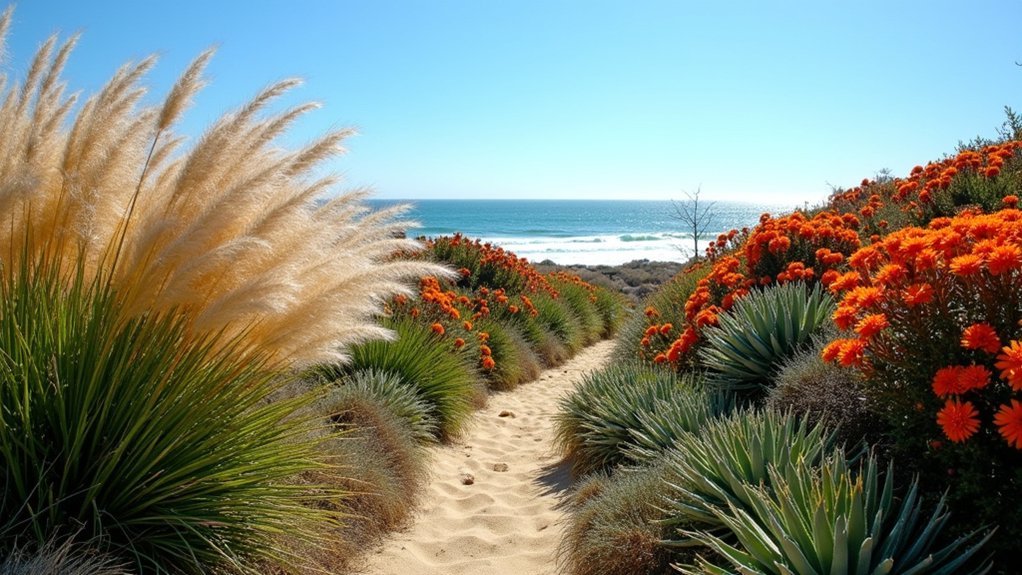
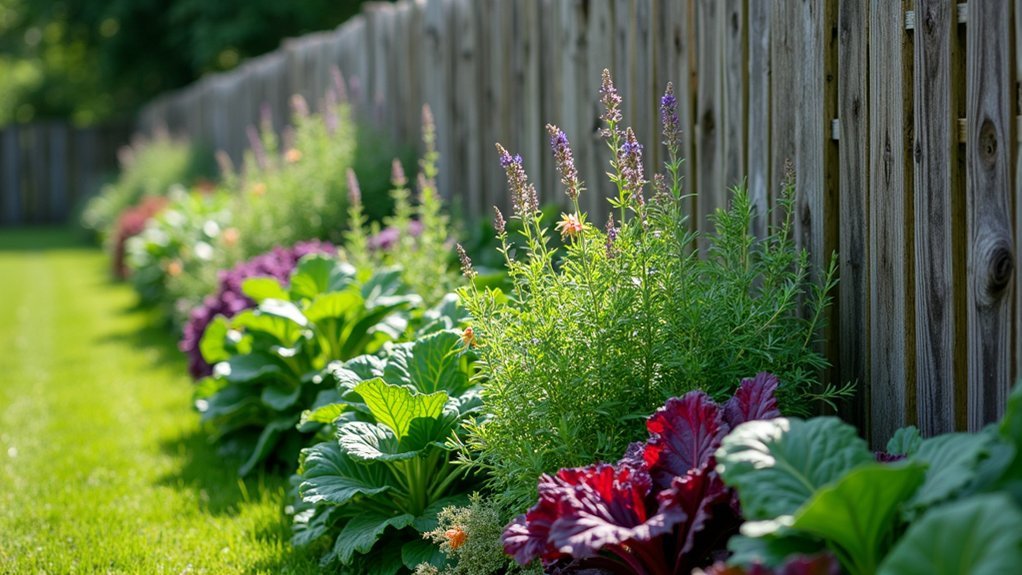
Leave a Reply